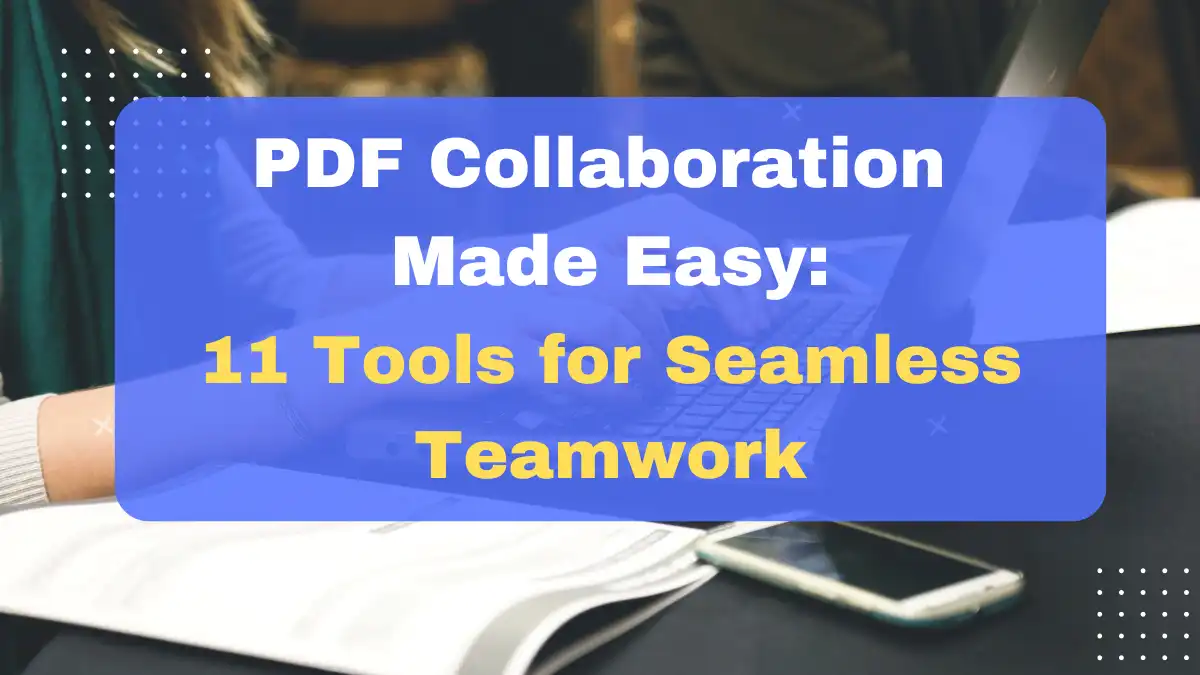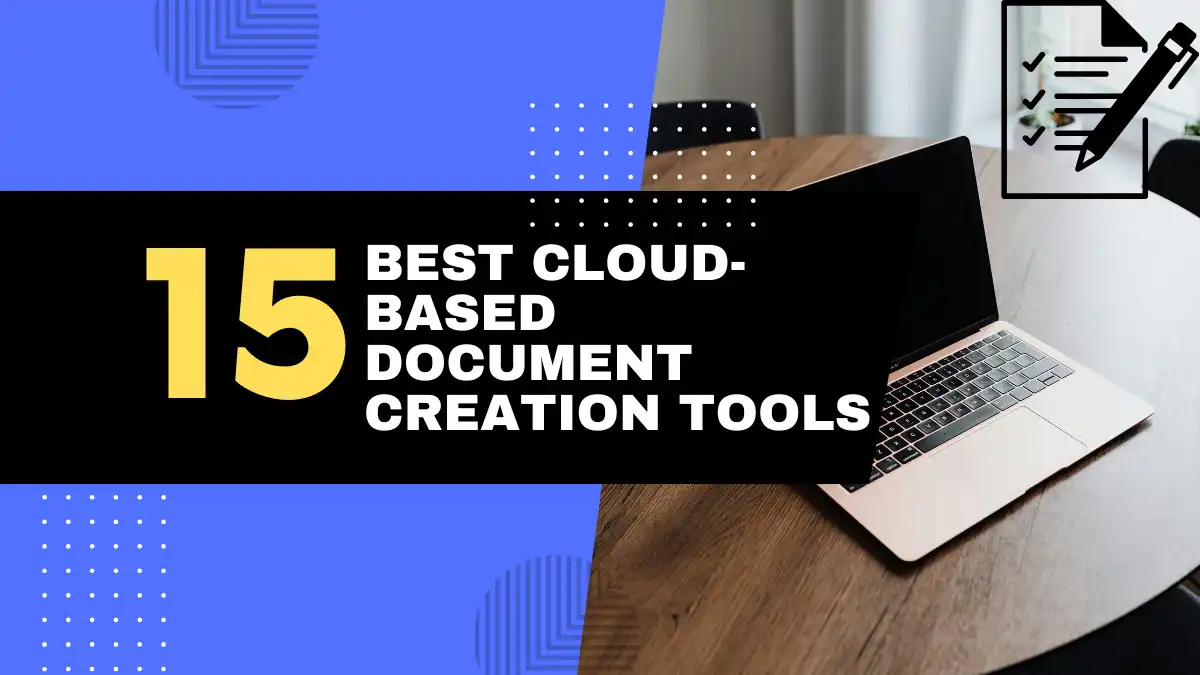
Picture this: You’re racing to meet a project deadline, and the client’s contract draft has been circulating among five team members for days. Your inbox is overflowing with subject lines like “Contract_v3_final_REVISED_2.pdf” and “Contract_JanesEdits_v4.pdf.” You’re spending more time figuring out which PDF contains what changes than actually implementing valuable feedback. The anxiety builds as you wonder: Did you miss critical legal edits buried in one of those versions? Are you about to present an outdated document to the client? This PDF collaboration nightmare is all too common in professional environments, causing missed deadlines, costly errors, and team frustration. Even in 2025, when digital collaboration should be seamless, PDF documents continue to create unexpected workflow challenges for teams of all sizes.
As remote and hybrid work environments become increasingly common in 2025, effective document collaboration has never been more critical. PDF collaboration tools have evolved significantly to address these challenges, transforming what was once a static document format into a dynamic platform for teamwork.
This comprehensive guide explores the landscape of PDF collaboration, focusing on collaborative PDF editors, PDF annotation collaboration, and online PDF collaboration solutions. We’ll examine the essential features of these tools, compare top options on the market, and provide actionable strategies to optimize your team’s PDF workflow. Whether you’re managing client approvals, coordinating document reviews, or facilitating team feedback, this article will help you identify the best PDF collaboration approach for your specific needs.
1. Understanding the Essentials of PDF Collaboration 🔍
Before diving into specific tools and strategies, it’s important to understand what PDF collaboration entails and why it has become so crucial for modern teams.
1.1 What is a Collaborative PDF Editor?
A collaborative PDF editor is a software solution that allows multiple users to view, edit, comment on, and modify PDF documents simultaneously or asynchronously. Unlike traditional PDF editors that limit collaboration to a single user at a time, collaborative editors create a shared workspace where team members can contribute to PDF documents regardless of their physical location.
The evolution of these tools has been remarkable. Early collaborative PDF solutions were often clunky, requiring documents to be converted to different formats before editing. Today’s collaborative editors work directly with the PDF format, preserving formatting while enabling real-time changes.
1.2 Core Features: Editing, Annotation, and Commenting
Modern collaborative PDF editors typically include three core functionality clusters:
Document Editing Features:
- Text modification and formatting
- Image insertion and manipulation
- Form field creation and management
- Page organization (adding, removing, reordering)
- Content redaction and extraction
Annotation Capabilities:
- Highlighting, underlining, and strikethrough
- Drawing tools for freehand markup
- Stamps and watermarks
- Shape insertion (rectangles, circles, arrows)
- Measurement tools
Commenting Systems:
- Text comments and sticky notes
- Voice annotations
- @mentions to tag specific team members
- Comment threading for organized discussions
- Comment resolution tracking
According to a 2025 survey by Document Management Quarterly, teams that utilize all three feature sets report 43% faster document approval cycles compared to those using basic PDF tools.
1.3 Real-time vs. Asynchronous Collaboration
PDF collaboration tools generally fall into two categories:
Real-time Collaboration:
- Multiple users can edit simultaneously
- Changes appear instantly for all participants
- Ideal for brainstorming sessions and meetings
- Often includes presence indicators showing who’s viewing
- May feature cursor tracking to see others’ positions
Asynchronous Collaboration:
- Team members work on documents at different times
- Changes are merged when documents are saved
- Better for detailed review processes
- Typically offers more robust version control
- Often includes notification systems for changes
Most modern platforms support both approaches, allowing teams to switch between modes depending on their specific needs. A 2025 WorkTrends study found that teams using a hybrid approach—real-time for ideation and asynchronous for refinement—completed projects 37% faster than those committed to a single collaboration mode.
1.4 The Importance of PDF Annotation Collaboration
PDF annotation collaboration refers specifically to the process of marking up, commenting on, and providing feedback on PDF documents in a collaborative environment.
1.5 Providing Feedback and Review Efficiently
Effective annotation tools transform passive document review into an interactive process through:
- Contextual commenting that ties feedback directly to relevant content
- Annotation categorization (question, suggestion, correction)
- Priority flagging for critical feedback
- Annotation filtering and sorting capabilities
- Bulk annotation management for similar comments
These capabilities significantly reduce the cognitive load associated with document review. Research from the 2025 Digital Workplace Report indicates that structured annotation systems reduce review time by up to 52% compared to email-based feedback.
1.6 Streamlining Document Approval Processes
Beyond simple feedback, PDF annotation collaboration tools can formalize approval workflows:
- Customizable approval pathways with sequential or parallel routing
- Digital signature integration for formal sign-offs
- Automated reminders for pending approvals
- Visual approval status indicators
- Audit trails documenting the approval process
Organizations implementing structured PDF approval systems report a 64% reduction in approval cycle time and a 77% decrease in approval-related errors, according to Workflow Analytics Partners’ 2025 benchmark study.
1.7 Benefits of Online PDF Collaboration
While desktop PDF solutions still exist, online PDF collaboration platforms have become the standard for most teams due to their significant advantages.
1.8 Accessibility from Any Device and Location
Online PDF collaboration enables:
- Browser-based access without software installation
- Cross-platform compatibility (Windows, macOS, Linux, mobile OS)
- Responsive interfaces that adapt to screen sizes
- Offline capabilities with synchronization when reconnected
- Lower hardware requirements by leveraging cloud processing
A recent survey found that 78% of knowledge workers now expect to be able to review and comment on PDFs from mobile devices, with 43% reporting doing significant document work while commuting or traveling.
1.9 Centralized Document Storage and Management
Cloud-based PDF collaboration offers substantial document management benefits:
- Single source of truth for all documents
- Automated backup and disaster recovery
- Centralized permission management
- Searchable document repositories
- Integration with broader document management systems
Organizations using centralized PDF storage report 68% less time spent searching for documents and a 41% reduction in instances of working on outdated document versions.
2. Top Tools for Effective PDF Collaboration 🛠️
With a clear understanding of PDF collaboration fundamentals, let’s explore some of the leading tools available in 2025.
2.1 Cloud-Based Collaborative PDF Editors
Cloud-based solutions offer the most seamless experience for team collaboration on PDF documents.
2.2 Tool 1: Adobe Acrobat Pro DC (2025 Cloud Edition)
Key Features:
- Enterprise-grade security with AES-256 encryption
- AI-assisted editing suggestions
- Real-time co-editing with up to 30 simultaneous users
- Automated text recognition (OCR) in 25+ languages
- Integration with Adobe Creative Cloud suite
Best Use Cases:
- Enterprise environments requiring strict security compliance
- Creative teams working with graphics-heavy documents
- Organizations already invested in the Adobe ecosystem
- Legal teams requiring certified electronic signatures
- Marketing teams collaborating on brand documentation
Recent enhancements in the 2025 version include predictive annotation suggestions and natural language processing for automated comment summarization, reducing review time by approximately 28%.
2.3 Tool 2: Bluebeam Revu Collaborate
Key Features:
- Industry-leading markup and measurement tools
- Specialized toolsets for architecture, engineering, and construction
- Powerful document comparison capabilities
- Custom markup shortcuts and tool sets
- 3D PDF support and integration
Best Use Cases:
- Construction project coordination
- Architectural drawing review
- Engineering document markup
- Facilities management
- Government contracting
Bluebeam’s specialized focus on technical industries makes it particularly valuable for field teams, with 87% of users reporting significant improvement in coordination between office and site personnel.
2.4 Tool 3: PDFelement Collaborate
Key Features:
- Intuitive interface with minimal learning curve
- Batch processing for multiple documents
- Advanced form creation and data collection
- AI-powered redaction and sensitive data protection
- Competitive pricing with flexible licensing
Best Use Cases:
- Small to medium businesses with budget constraints
- Teams new to PDF collaboration
- Form-heavy workflows
- Educational institutions
- Non-profit organizations
PDFelement has gained significant market share since 2023, with a 2025 Collaboration Tools Survey ranking it highest in the “ease of adoption” category.
2.5 PDF Annotation Collaboration Platforms
Some solutions specialize specifically in the annotation and review process rather than full editing capabilities.
2.6 Tool 1: DocuSketch Annotate
Key Features:
- Voice-to-text annotation capabilities
- Visual heatmaps showing annotation density
- Annotation categorization and tagging system
- Automated annotation summary generation
- Visual comparison of annotation sets
Best Use Cases:
- Detailed document review processes
- Academic peer review
- Content development and approval
- Medical documentation review
- Contract negotiation
DocuSketch’s innovative approach to visual annotation representation helps teams quickly identify contentious sections of documents, reducing review cycles by up to 41%.
2.7 Tool 2: MarkupHero
Key Features:
- Machine learning-powered suggestion grouping
- Semantic analysis of comments for sentiment and intent
- Automated action item extraction from annotations
- Timeline visualization of document evolution
- Integration with project management platforms
Best Use Cases:
- Managing complex stakeholder feedback
- Content marketing approval workflows
- Product documentation development
- UX design documentation
- Regulatory compliance review
MarkupHero’s AI-driven approach to annotation management makes it particularly effective for documents requiring input from large numbers of stakeholders.
| Feature | DocuSketch Annotate | MarkupHero |
|---|---|---|
| AI-Assisted Analysis | Limited | Comprehensive |
| Comment Organization | Manual Categories | Automated Clustering |
| Integrations | 12+ platforms | 30+ platforms |
| Mobile Support | iOS, Android | iOS, Android, Progressive Web App |
| Offline Capabilities | Limited | Full |
| Pricing Model | Per User | Per Document Set |
2.8 Mobile PDF Collaboration Apps
As mobile work continues to increase, dedicated mobile applications for PDF collaboration have become essential.
2.9 Tool 1: LiquidText Pro
Key Features:
- Multi-document workspace on a single screen
- Gesture-based annotation and organization
- Concept mapping and relationship visualization
- Document section comparison
- Cloud synchronization across devices
Best Use Cases:
- Research-intensive document review
- Legal case preparation
- Executive document briefing
- Comparative document analysis
- Academic research
LiquidText’s innovative approach to document interaction has earned it multiple design awards, with users reporting 37% faster information extraction compared to traditional PDF apps.
2.10 Tool 2: PDF Expert Teams
Key Features:
- Optimized performance on mobile devices
- Digital pen and Apple Pencil support with pressure sensitivity
- Offline annotation with background syncing
- Simplified user interface for mobile productivity
- Quick signing and approval workflows
Best Use Cases:
- Field teams requiring document access
- Executives reviewing documents while traveling
- Sales teams managing contracts on the go
- Healthcare providers reviewing patient documentation
- Remote inspection and compliance verification
PDF Expert Teams has become the standard for mobile PDF collaboration, with a 2025 survey showing it’s installed on 72% of corporate mobile devices that manage PDFs.
3. Optimizing Your PDF Collaboration Workflow 🔄
Having the right tools is only part of the equation. Establishing effective processes is equally important for successful PDF collaboration.
3.1 Best Practices for Effective Annotation and Feedback
Clear protocols improve the quality and efficiency of document feedback.
3.2 Clear Communication and Commenting Guidelines
Successful teams typically establish:
- Standardized annotation color coding (e.g., red for errors, yellow for questions)
- Agreed-upon abbreviations and symbols
- Templates for common feedback patterns
- Expectations for comment specificity and actionability
- Guidelines for constructive tone and phrasing
Organizations with documented annotation protocols report 47% faster document revisions and 64% fewer instances of miscommunication about feedback intent.
3.3 Utilizing Markup Tools Effectively
Beyond basic commenting, strategic use of markup tools improves collaboration through:
- Using distinct annotation types for different feedback categories
- Combining markups with explanatory comments
- Grouping related annotations
- Leveraging measurement tools for precise feedback
- Using drawing tools to propose visual solutions
Teams trained in advanced markup techniques resolve design and layout issues 58% faster than those using basic text commenting alone.
3.4 Managing Version Control and Conflicting Edits
Version control is one of the most challenging aspects of PDF collaboration.
3.5 Utilizing Version History and Change Tracking
Effective version management strategies include:
- Establishing consistent version naming conventions
- Regular milestone versions with clear labeling
- Utilizing comparison tools to visualize changes
- Document locking for critical editing phases
- Automated version backup policies
A 2025 Document Management Institute study found that organizations with formal PDF version control protocols experienced 76% fewer instances of work being lost or duplicated.
3.6 Implementing Clear Document Ownership
Defining roles and responsibilities prevents confusion:
- Designating primary document owners
- Establishing edit vs. comment permissions hierarchy
- Creating clear handoff procedures
- Defining escalation paths for conflicting feedback
- Setting revision acceptance criteria
When formalized ownership protocols exist, teams report 52% fewer delays related to approval uncertainty and 41% faster final document delivery.
3.7 Ensuring Secure PDF Collaboration
Security concerns remain paramount when collaborating on potentially sensitive documents.
3.8 Permission Settings and Access Controls
Comprehensive security approaches include:
- Role-based access control (RBAC) implementation
- Temporary access provisioning for external stakeholders
- Watermarking for sensitive documents
- Device-specific access limitations
- Automatic access expiration settings
Organizations implementing tiered PDF access controls report 83% fewer incidents of inappropriate document sharing.
3.9 Data Encryption and Compliance
Modern PDF collaboration requires:
- End-to-end encryption for documents in transit
- At-rest encryption for stored documents
- Compliance with industry regulations (GDPR, HIPAA, etc.)
- Audit logging of all document interactions
- Data residency controls for international teams
The average cost of a document-related data breach has reached $4.1 million in 2025, making security a critical consideration for any PDF collaboration implementation.
4. Frequently Asked Questions (FAQ) About PDF Collaboration ❓
4.1 What are the best free tools for PDF annotation collaboration?
Several free tools offer solid PDF annotation capabilities:
- Xodo PDF – Provides robust annotation tools with limited real-time collaboration features in its free tier. Best for small teams with basic needs.
- Kami – Originally designed for education but useful for any team. Offers highlighting, commenting, and drawing tools with 3 collaborators in the free version.
- PDF24 Collaborate – A surprisingly powerful free tool with annotation capabilities and basic version tracking. Limited to 5 documents in active collaboration.
- Google Drive with PDF Viewer – While not a dedicated PDF tool, it offers basic annotation and commenting with excellent sharing capabilities.
For teams with minimal budgets, Xodo PDF typically offers the best balance of features and usability without cost. However, free tools generally lack advanced features like real-time co-editing, comprehensive version control, and enterprise-grade security.
4.2 How can I edit a PDF collaboratively in real-time?
Real-time collaborative PDF editing requires:
- A cloud-based PDF editor with real-time capabilities (Adobe Acrobat Online, PDFelement Collaborate, or Bluebeam Studio)
- All participants having proper access permissions
- Stable internet connections for all collaborators
- Awareness of concurrent editing indicators to avoid conflicts
The most effective approach is to:
- Share the document link with collaborators
- Establish editing zones to prevent interference
- Utilize the chat or comment function to coordinate efforts
- Save frequent milestones to prevent data loss
Most real-time collaboration tools indicate which sections others are currently editing using colored highlights or user icons, helping prevent direct conflicts.
4.3 Is online PDF collaboration secure?
The security of online PDF collaboration depends on:
- The specific platform’s security measures
- Your organization’s implementation and policies
- User adherence to security protocols
Enterprise-grade solutions like Adobe Acrobat DC, Bluebeam Studio, and PDFelement Collaborate offer:
- End-to-end encryption (typically AES-256)
- SOC 2 compliance
- Regular security audits
- Multi-factor authentication
- Granular permission controls
For sensitive documents, look for:
- Zero-knowledge encryption options
- Data residency guarantees
- Digital rights management features
- Watermarking capabilities
- Comprehensive audit logs
When implemented properly, modern online PDF collaboration can be highly secure. However, it’s crucial to evaluate any platform against your specific security requirements and compliance needs.
4.4 How do I manage version control in a collaborative PDF editor?
Effective PDF version control strategies include:
- Establish naming conventions Example: ProjectName_DocumentType_YYYYMMDD_V##
- Utilize built-in versioning features Most collaboration platforms automatically track versions, allowing reversion when needed
- Create milestone versions at key points Designate certain versions as significant milestones for future reference
- Implement check-out systems when possible Prevents conflicting simultaneous edits
- Use comparison tools regularly Visually confirm changes between versions to catch unintended alterations
- Document version-specific notes Record what changed and why for each significant version
The most sophisticated platforms now offer branching capabilities similar to software development, allowing teams to explore alternative document approaches before merging changes back to the main version.
4.5 Can I collaborate on PDFs from my mobile device?
Mobile PDF collaboration has advanced significantly, with several approaches available:
- Dedicated mobile apps from major providers (Adobe Acrobat Reader, Bluebeam Revu, PDFelement)
- Specialized mobile-first solutions like LiquidText and PDF Expert
- Responsive web interfaces that adapt to mobile browsers
Mobile collaboration capabilities now include:
- Touch-optimized annotation tools
- Digital pen support for precise markup
- Offline editing with background synchronization
- Camera integration for adding photos to comments
- Voice annotation for hands-free feedback
According to the 2025 Mobile Productivity Report, 64% of knowledge workers now regularly review and annotate PDFs on mobile devices, with 37% reporting they perform significant editing tasks on tablets with keyboard attachments.
Conclusion 🏁
As we’ve explored throughout this comprehensive guide, PDF collaboration tools have evolved dramatically to meet the demands of modern teamwork. The days of static PDFs being emailed back and forth with tracked changes and conflicting feedback are rapidly fading into history. Today’s collaborative PDF editors, PDF annotation collaboration platforms, and online PDF collaboration solutions offer unprecedented capabilities for teams to work together effectively on documents, regardless of location or device. The transformation of PDF collaboration technology represents one of the most significant productivity advancements for document-centric teams in recent years.
The benefits of implementing effective PDF collaboration are substantial. Organizations leveraging these tools report faster approval cycles, reduced miscommunication, improved document quality, and significantly higher team satisfaction. Whether you’re in a creative field requiring detailed visual feedback, a technical industry with complex documentation needs, or any business that relies on document workflows, the right PDF collaboration approach can transform your productivity.
As we look to the future, PDF collaboration will continue to evolve with advancements in artificial intelligence, extended reality interfaces, and deeper integration with other productivity tools. The fundamental PDF format itself is showing remarkable resilience, adapting to accommodate new collaboration paradigms while maintaining its position as a universal document standard.
The key to success lies not just in selecting the right tools but in implementing thoughtful processes that match your team’s specific needs. By combining appropriate technology with clear collaboration protocols, you can harness the full potential of PDF collaboration to streamline workflows, improve outcomes, and enable your team to focus on what truly matters—creating great work together.
Have you implemented PDF collaboration tools in your organization? What challenges and successes have you experienced? The landscape continues to evolve, and sharing experiences helps the entire community advance together in this essential aspect of modern teamwork.
Looking for more document collaboration tools? Check out our related guides on The Ultimate Guide to Collaborative Document Tools: Software, Features, and Best Practices.






